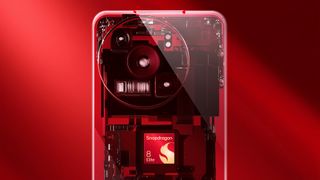Qualcomm's top-of-the-line mobile chip is getting a new name. But the newly unveiled Snapdragon 8 Elite offers more than just surface changes as it's built on a 3-nanometer process, features a new CPU and promises plenty of neural processing to handle new on-device AI features.
The Snapdragon 8 Elite should power the upcoming Samsung Galaxy S25 series and all of the best Android phones for the coming year.
Qualcomm showed off the Snapdragon 8 Elite today (October 21), talking up its many upgrades during the chip maker's annual Snapdragon Summit. And these are changes you're going to want to know about if you're interested in upgrading to a new Android phone — and how it might challenge Apple's iPhone 16 lineup.
Here's what we know about the Snapdragon 8 Elite based on Qualcomm's preview and what it potentially means for phones powered by the new chipset.
What devices will use the Snapdragon 8 Elite

We won't have to wait long to see phones that feature this new system-on-chip. Qualcomm listed nine phone makers committed to featuring the Snapdragon 8 Elite and said those companies "are poised to launch devices powered by the Snapdragon 8 Elite, in the coming weeks."
Notably, Samsung and OnePlus are included in the list of companies pledging to feature the Snapdragon 8 Elite along with Asus, Xiaomi, Honor, Oppo and a number of other device makers who primarily do business in China. While no specific models have been mentioned — those kind of announcements are generally left to phone makers — it's more evidence that we'll see the Snapdragon 8 Elite in at least some of Samsung's Galaxy S25 models as well as the OnePlus 13.
The OnePlus 13 is tipped to launch in China first in October 31 but the release date is not yet known. Similarly, we're expecting Samsung to host its Galaxy S25 launch event in January, at which time we'll see if the Snapdragon 8 Elite powers just the Galaxy S25 Ultra globally or whether it's featured in other S25 models outside of North America.
We already know some of the phones that will feature the Snapdragon 8 Elite. Asus plans to reveal the ROG Phone 9 with the new chipset in November while the Honor Magic 7 will also use Qualcomm's latest chipset.
Snapdragon 8 Elite performance

We've got good news if you're looking for a mobile powerhouse.
Like Apple's A18 silicon, the Snapdragon 8 Elite will be built on a 3nm process, an improvement over the 4nm process that the current Snapdragon 8 Gen 3 uses. The smaller the process, the closer transistors are packed together, improving both performance and power efficiency. Considering the Snapdragon 8 Gen 3 wasn't exactly a shrinking violet in either department, that bodes well for the speed and battery life of Snapdragon 8 Elite-powered devices.
Qualcomm has made another change to its chipset. As had been announced prior to today's unveiling, the Kryo CPU used on previous Snapdragon 8 chipsets is giving way to a version of Qualcomm's Oryon CPU customized for mobile. Oryon is the CPU featured in Qualcomm's Snapdragon X Elite silicon for connected computing, and Qualcomm says that using a second-generation version of that chip will optimize browsing, gaming and other experiences on mobile devices.
The Oryon CPU used for the Snapdragon 8 Elite introduces a brand new architecture with two prime cores running at 4.3GHz and six performance cores, which are designed to handle intensive tasks while maximizing power efficiency. Qualcomm is dropping efficiency cores from this version of Oryon, continuing a trend of using fewer efficiency cores in its CPUs.
The microarchitecture also introduces a data pre-fetcher which Qualcomm says can boost performance. It supports an Instant Wake feature that essentially eliminates the wake-up sequence so that a core can get right to the task at hand.
In terms of performance, Qualcomm says to expect 45% improvements in both single-core and multicore tasks over the Snapdragon 8 Gen 3, with web browsing speeding up by 62%. At the same time, CPU power efficiency should improve by 44% with the Oryon CPU.
Qualcomm shared some benchmarks for the Snapdragon 8 Elite, in which a reference device powered by the chipset averaged single and multicore scores of 3,221 and 10,426 on Geekbench 6. We'll have a chance to run some tests on the Snapdragon 8 Elite later this week, so we can verify those numbers, but if they prove accurate, they'll easily the top the 2,300 single-core and 7,249 multicore numbers we got when testing the Snapdragon 8 Gen 3-powered Galaxy S24 Ultra.
The single-core score of the Snapdragon 8 Elite would be on par with the iPhone 16 Pro Max's 3,386 result. But the multicore number would best the iPhone 16 Pro Max score by 26%. Get ready for the iPhone vs. Android debate to reignite.
Snapdragon 8 Elite graphics

The Oryon CPU isn't the only part of the system-on-chip seeing changes. The Snapdragon 8 Elite's Adreno GPU is getting a boost, too, with a new sliced architecture that dedicates memory for each slice, which should result in faster and smoother gameplay that lasts longer thanks to battery life improvements. In fact, Qualcomm is promising that gaming sessions can last 2.5 hours longer on Snapdragon 8 Elite device thanks to the GPu improvements.
The sliced architecture should also support more cinematic and detailed landscapes, continuing to establish mobile devices as a formidable gaming platform.
Recent Adreno GPUs on Qualcomm's mobile chipsets have focused on ray-tracing support, and that continues with the Snapdragon 8 Elite. Qualcomm promises a 35% improvement in ray-tracing. Meanwhile, the Snapdragon 8 Elite brings mobile support for Unreal Engine 5.3 with Nanite, raising the possibility of more immersive 3-D environments for games on mobile. Qualcomm also optimized support for Unreal Chaos Physics Engine with its GPU.
All told, Qualcomm expects a 40% improvement in performance from the Snapdragon 8 Elite's Adreno GPU, compared to last year's silicon. Power efficiency should improve by 40% for the GPU. According to Qualcomm's benchmarks, the Snapdragon 8 Elite-powered reference device posted an average score of 159 frames per second on the 3DMark Wild Life Unlimited test, which would be a 28% improvement over what we saw from the Galaxy S24 Ultra. It also widens the gap with iPhones, as the A18 Pro-powered iPhone 16 Pro Max only hit 107.5 fps on that same test.
Snapdragon 8 Elite AI

Every premium phone worth its price tag these days wants to deliver AI-powered features — especially if they can be handled on the device itself. The Snapdragon 8 Elite is making its pitch to meet this demand by integrating multimodal generative AI applications for support on-device experiences. And it plans to do this while protecting your privacy and reducing latency.
That requires a new architecture for the AI engine on the Snapdragon silicon aided by the Oryon CPU, which not on-device processes latency-critical AI tasks, but initiates AI workloads. As a Qualcomm executive puts it, Oryon is doing the heavy lifting while other parts of the neural engine take on AI-specific tasks.
According to Qualcomm, the end result should boost the neural processing unit's speed by 45% over last year's version. Additionally, Qualcomm added colors to both the scaler and vector accelerators to handle the demands of generative AI.
Significantly, the Snapdragon 8 Elite supports a higher capacity of tokens, meaning users can supply the AI assistant on board their phone wither larger files to process. And the Qualcomm Sensing Hub has been improved to better understand your personal context for more personalized output for your queries.
Snapdragon 8 Elite image processing
It's also worth taking note of the changes introduced to the image signal processor on board the Snapdragon 8 Elite. Qualcomm updated the Hexagon Direct Link between the redesigned AI ISP and neural engine to bring AI enhancements to photos. Those features include using AI to extend the borders of a photo beyond its frame, sharper resolution and clarity for images and improve AI segmentation to identify individual objects and enhance them. Specific to that last feature, Qualcomm's chipset can segment an image into more than 250 layers, optimizing each one for more natural skin tones, sharper-looking skies and more.
In addition to AI-enhanced autofocus, auto white balance and auto exposure, pixel throughput has increased by 35% to 4.3 gigapixel per second. That allows the Snapdragon 8 Elite to record from three 48MP sensors simultaneously at 30 fps.
The AI ISP brings Magic Editor-style eraser capabilities to video, in which you can turn to the Video Object Eraser to remove unwanted objects from your video footage, with the editing taking place entirely on device instead of having you upload your footage to the cloud for processing. Additionally, the updated chipset will support low-light video capture at 4K/60fps resolutions.
Other Snapdragon 8 Elite improvements
There are a few other Snapdragon 8 Elite capabilities worth taking note of. The new chipset includes Qualcomm's Snapdragon X80 5G Modem-RF System for improved connectivity, and it integrates Wi-Fi, Bluetooth, and UWB to help with location proximity. There's Wi-Fi 7 support through Qualcomm's FastConnect 7900 Mobile Connectivity System.
Qualcomm's Snapdragon Summit continues through Wednesday (October 23), with the promise of more demos showcasing the Snapdragon 8 Elite's capabilities. We'll update this Snapdragon 8 Elite reference guide with more details as they become available.
More from Tom's Guide
- iPhone SE — all the rumors and what we want to see
- 7 ways the Galaxy S25 Ultra could beat the iPhone 16 Pro Max
- Best phones overall















)





 English (US) ·
English (US) ·